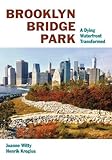Brooklyn Bridge Park : A Dying Waterfront Transformed / Henrik Krogius, Joanne Witty.
Material type: TextPublisher: New York, NY : Fordham University Press, [2022]Copyright date: ©2016Description: 1 online resource (272 p.) : 50 Black & White and Color IllustrationsContent type:
TextPublisher: New York, NY : Fordham University Press, [2022]Copyright date: ©2016Description: 1 online resource (272 p.) : 50 Black & White and Color IllustrationsContent type: - 9780823273584
- online - DeGruyter
| Item type | Current library | Call number | URL | Status | Notes | Barcode | |
|---|---|---|---|---|---|---|---|
 eBook
eBook
|
Biblioteca "Angelicum" Pont. Univ. S.Tommaso d'Aquino Nuvola online | online - DeGruyter (Browse shelf(Opens below)) | Online access | Not for loan (Accesso limitato) | Accesso per gli utenti autorizzati / Access for authorized users | (dgr)9780823273584 |
Browsing Biblioteca "Angelicum" Pont. Univ. S.Tommaso d'Aquino shelves, Shelving location: Nuvola online Close shelf browser (Hides shelf browser)

|

|

|

|

|

|

|
||
| online - DeGruyter The Poetics of Ruins in Renaissance Literature / | online - DeGruyter Coming / | online - DeGruyter Before the Fires : An Oral History of African American Life in the Bronx from the 1930s to the 1960s / | online - DeGruyter Brooklyn Bridge Park : A Dying Waterfront Transformed / | online - DeGruyter Citizen Subject : Foundations for Philosophical Anthropology / | online - DeGruyter Heidegger, Philosophy, and Politics : The Heidelberg Conference / | online - DeGruyter The Muses on Their Lunch Hour / |
restricted access online access with authorization star
http://purl.org/coar/access_right/c_16ec
A major social and political phenomenon of how a community overcame overwhelming opposition and obstacles to build the Brooklyn Bridge Park. Stretching along a waterfront that faces one of the world’s greatest harbors and storied skylines, Brooklyn Bridge Park is among the largest and most significant public projects to be built in New York in a generation. It has transformed a decrepit industrial waterfront into a new public use that is both a reflection and an engine ofBrooklyn’s resurgence in the twenty-first century. Brooklyn Bridge Park unravels the many obstacles faced during the development of the park and suggests solutions that can be applied to important economic and planning issues around the world. Situated below the quiet precincts of Brooklyn Heights, a strip of moribund structures that formerly served bustling port activity became the site of a prolonged battle. The Port Authority of New York and New Jersey eyed it as an ideal location for high-rise or commercial development. The idea to build Brooklyn Bridge Park came from local residents and neighborhood leaders looking for less intensive uses of the property. Together, elected officials joined with members of the communities to produce a practical plan, skillfully won a commitment of government funds in a time of fiscal austerity, then persevered through long periods of inaction, abrupt changes of government, two recessions, numerous controversies often accompanied by litigation, and a superstorm.Brooklyn Bridge Park is the success story of a grassroots movement and community planning that united around a common vision. Drawing on the authors’ personal experiences—one as a reporter, the other as a park leader—Brooklyn Bridge Park weaves together contemporaneous reports of events that provide a recordof every twist and turn in the story. Interviews with more than sixty people reveal the human dynamics that unfolded in the course of building the park, including attitudes and opinions that arose about class, race, gentrification, commercialization, development, and government.Despite the park’s broad and growing appeal, its creation was lengthy, messy, and often contentious. Brooklyn Bridge Park suggests ways other civic groups can address such hurdles within their own communities.
Mode of access: Internet via World Wide Web.
In English.
Description based on online resource; title from PDF title page (publisher's Web site, viewed 24. Mai 2022)


